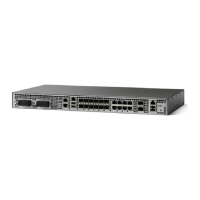LSP Network Management
To manage a Multiprotocol Label Switching (MPLS) network you must have the ability to monitor label
switched paths (LSPs) and quickly isolate MPLS forwarding problems. You need ways to characterize the
liveliness of an LSP and reliably detect when a label switched path fails to deliver user traffic.
You can use MPLS LSP Ping to verify the LSP that is used to transport packets destined for IPv4 Label
Distribution Protocol (LDP) prefixes, traffic engineering (TE) tunnels, and Any Transport over MPLS
pseudowire Forwarding Equivalence Classes (AToM PW FECs). You can use MPLS LSP Traceroute to trace
LSPs that are used to carry packets destined for IPv4 LDP prefixes and TE tunnel FECs.
An MPLS echo request is sent through an LSP to validate it. A TTL expiration or LSP breakage causes the
transit device to process the echo request before it gets to the intended destination and returns an MPLS echo
reply that contains an explanatory reply code to the originator of the echo request.
The successful echo request is processed at the egress of the LSP. The echo reply is sent via an IP path, an
MPLS path, or a combination of both back to the originator of the echo request.
ICMP ping and trace Commands and Troubleshooting
Internet Control Message Protocol (ICMP) ping and trace commands are often used to help diagnose the root
cause of a failure. When a label switched path (LSP) is broken, the packet might make its way to the target
device by way of IP forwarding, thus making ICMP ping and traceroute unreliable for detecting Multiprotocol
Label Switching (MPLS) forwarding problems. The MPLS LSP Ping, Traceroute and AToM VCCV feature
extends this diagnostic and troubleshooting ability to the MPLS network and handles inconsistencies between
the IP and MPLS forwarding tables, inconsistencies in the MPLS control and data plane, and problems with
the reply path.
The figure below shows a sample topology with a Label Distribution Protocol (LDP) LSP and traffic engineering
(TE) tunnel LSP.
Figure 11: Sample Topology with LDP and TE Tunnel LSPs
This section contains the following topics:
MPLS LSP Ping and Traceroute Discovers LSP Breakage
Configuration for Sample Topology
These are sample topology configurations for the troubleshooting examples in the following sections (see the
figure above). There are the six sample device configurations.
MPLS Basic Configuration Guide, Cisco IOS XE Everest 16.5.1 (Cisco ASR 900 Series)
85
MPLS LSP Ping, Traceroute, and AToM VCCV
LSP Network Management

